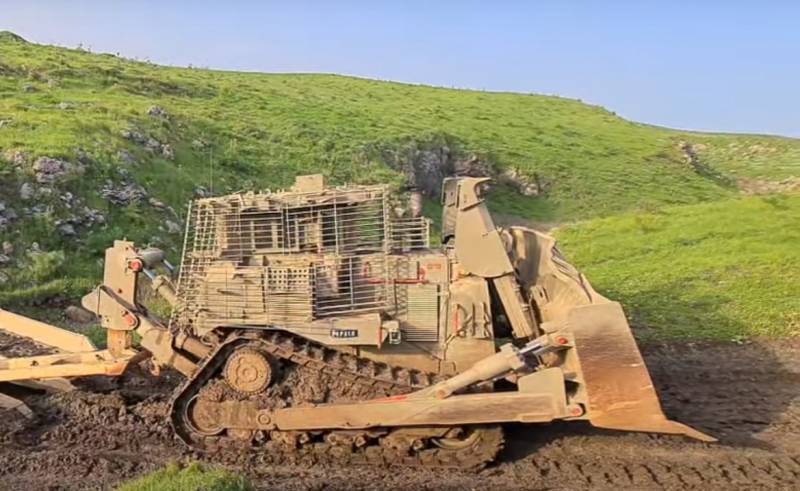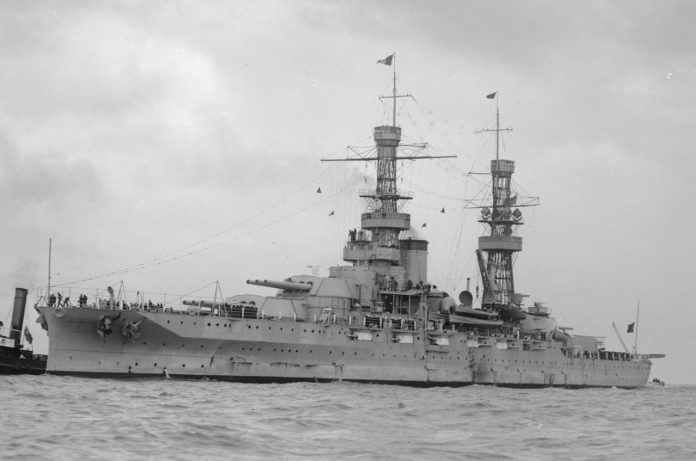
This article, we'll start with a little work on the bugs: the previous materialit is, dedicated to the main fire battleships "Pennsylvania", we have indicated, that the device, providing a slight delay during the volley (0,06 sec) between shots extreme and central weapons was first established in the US battleship in 1918 g. But in fact it was only in 1935 city: Americans really were able to 1918 g. reduce the dispersion of the main fire projectiles at half volley firing, but achieved this by other means, including - reduction in muzzle velocity.
How to shoot American battleships? Dear AV. Mandel in his monograph "Linear US ships" gives a detailed description of two such episodes, and the first of them - a record-shooting Battleship "Nevada" for 1924-25 gg. (more precisely, one of the credit firing). Judging by the description, During this time, the Americans have used progressive shooting training system, which, as far as the author of this article, the first to use the Germans before World War I.. As is known, classic naval artillery exercise is shooting the shield, but it has one serious flaw: shield can not be towed at high speed. In this way, shooting on the shield - it is always very low-speed shooting at targets.
Judging by the description of AV. Mandel just so happened the shooting, "Nevada", with the target ship was moving at a speed of 20 with. probably at a distance 90 cable. Word «probably» used because, that the distinguished author indicates no cables, and meters (16 500 m), but in English literature is generally not indicated Meters, and yards, in this case the distance was only 80 cable. Shooting was scheduled to begin, when the heading angle to the target amount 90 city., but the order to open fire went before, when the goal was to 57 city. and the first two the battleship salvo made during the ongoing reversal, what, generally, It does not contribute to the accuracy of shooting. All while shooting the battleship gave 7 bursts of 5 min. 15 sec.
After the first volley faulty rotating mechanism of one of the towers, but him, apparently, managed to "revive" by the second volley, so that the pass was not. However left gun missed first tower first and second discharge due to a fault in the electric trigger circuit. After the fifth salvo fixed drive failure vertical lay tower 4th, but it also put into operation and the tower continued to participate in shooting. During the 6th salvo cannon left third tower has given a pass because of a defective fuse, and in the final seventh one gun salvo fired incomplete charge (3 his cap in place 4), and again broke down drive vertical lay, Now the tower №2.
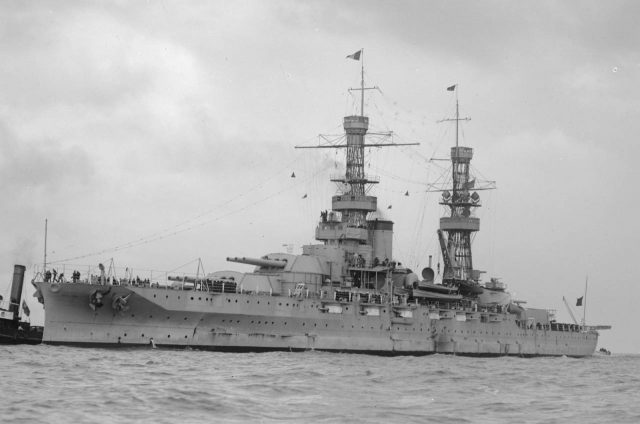
Linkor «Pennsylvania» at 1925 g.
AV. Mandel writes, that such failure was a rare thing, and then, to "Nevada" they quickly corrected during shooting, but then a respected author is not easy to accept. If we were talking about some unscheduled exercises, or about shooting, It took place shortly after the entry into operation, when many mechanisms still need to be improved, it still somehow could understand. But the date of credit firing is known in advance, ready for it and the crew and materiel - and, for all that, such an abundance of small failures. Note, failure as a result of only their own shooting, and what happened, if "Nevada" in this case was in the battle, and was exposed to the enemy's large-caliber shells?
As we have said previously, American battleships firing full broadsides, and of the three passes, for 7 bursts "Nevada" released 67 shells, one of which obviously could not hit the target, since it has been released incomplete charge. But this is - not a fault machinery, a charging error, did not report a single cap in the bolt, so the reason to exclude the projectile out of the total result of the shooting we have.
The first four volleys formed covering, but the results were not, on the fifth battleship observers counted one hit, and two more hits in the second and seventh volleys. And all 5 hits on 67 spent shells, respectively, accuracy was 7,46%.
AV. Mandel calls this outstanding result accuracy, citing the fact, that the famous "Bismarck" during a battle in the Denmark Strait showed less accuracy. But such a comparison is totally incorrect. Yes, really, "Bismarck" in the battle spent 93 shell, achieving three hits in "Prince of Wells" and, least, one in the "Hood". maybe, that "Bismarck" the British cruiser dead artillerymen have more hits and the number of, but even apart from the minimum, get, that "Bismarck" showed accuracy 4,3%. it, of course, below "Nevada" indicator by which we described above firings.
But it should be taken into account, the American battleship fired at a single target, following the same course, while the "Bismarck" fired sequentially two different ship, so he re-zeroing required, and, respectively, increased consumption of shells on it. In addition, during the battle the British ships maneuvered and there was much more difficult in them.
You also can not forget, that "Nevada" fired on 90 cable, and fight in the Danish Strait began on 120 cables and, perhaps, "Bismarck" destroyed "hood" before, the distance between these vessels was reduced to 90 cable. Still have some doubts, the visibility at the time of the battle in the Denmark Strait was as good, and that the shooting "Nevada": the fact, that the Americans sought their target practice with a clear lead, good weather, in order to smoothly watch downs practicing volleys ships. Interesting, that the United States itself were opponents of this "reduced" combat training, but their objections usually fend off the, that in the tropical Pacific, Where, According to Admirals, they had to fight with the Japanese fleet, such visibility has been the norm.
But the main objection to AV. Mandel is, what, usually, in combat accuracy at times, and then reduced by orders of magnitude relative to the, that was reached on the pre-war firing. So, at the beginning 1913 city, in the presence of the first Lord Admiralty, Battleship "Tanderer" correcting the shooting on the range 51 cbl. using the latest at the time the fire control devices made 82% hit. But in the Battle of Jutland, 3-Squadron Battlecruiser, fighting at a distance 40-60 cable's achieved only 4,56% hits and it was the best result of the Royal Navy. Of course, "Nevada" shot much more difficult conditions and long-range, yet his figure 7,46% It does not look too good.
Besides, I want to draw attention to the fact, that the first 4 ALPA, although formed covering, but did not give hits - of course, Sea is everyone, but still there is a strong feeling, that in spite of the measures to reduce the dispersion it was the American battleships too large. This is indirectly confirmed by the fact, Americans did not stop on the double reduction of dispersion, achieved by them 1918 city, but continued to work in this direction and further.
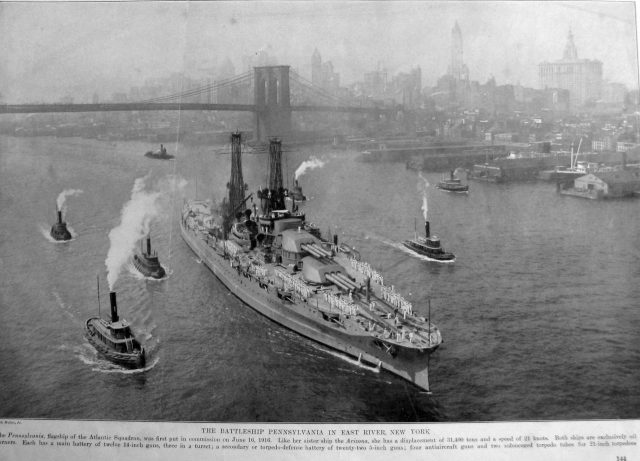
The second shooting, described AV. Mandel, produced battleship "New York" in 1931 g. Despite, that ships equipped with this type of two-gun turrets, in which the guns had individual cradle, when shooting at 60 cable's ship reached fairly moderate results: 7 results for 6 bursts, or 11,67%. In comparison with the pre-war British shooting - absolutely no significant result, but, in fairness, note, that "New York" shot at "conditional 20-node purpose" offset aiming point, the mechanism which we have described above, rather than the switchboard, and gave the first 4 volley on one goal and three others - on the other.
Generally, we can say, that the accuracy of US battleships raises questions even in the aftermath of the First World War, that is, even after, the US sailors "shaken" joint military exercises with the British fleet, before the results were obviously worse. No wonder that D. Bitti, who commanded the British battlecruisers, and later became First Lord of the Admiralty argued, that for the United States to England parity will be enough to have a fleet, on 30% less than the US.
But back to the design of the American three-gun turrets. Besides placing tools in a single cradle and the availability of only two of shell, and the same amount of charging lifts three guns, American Tower and featured yet another highly unusual "innovation", namely - placing ammunition.
In all those years battleships, artillery cellar with shells and charges were placed at the bottom of the tower installation, under the protection of the dogs and the citadel - but not in the American ships! more precisely, their storage charges placed approximately in the same, where European and battleships, but the shells ... shells are stored directly in the towers, and units of the main fire Barbet.
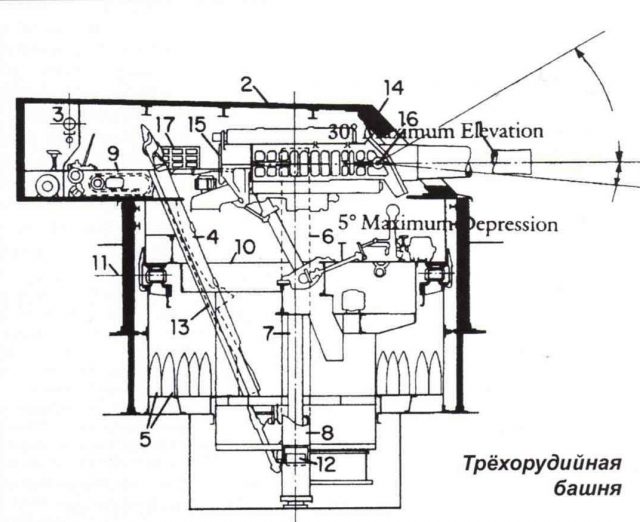
Interesting, that this diagram shows only the penultimate storage tier projectiles, and in fact they were placed above…
Directly placed in the tower 55 shells, including 22 - on both sides of guns, 18 - at the rear wall of the tower and 18 - at the level of the feed chute. The main ammunition was stored in the so-called "slug deck of the tower" - she was at the level of, According to VN. Chausov "second ship" deck. What was meant here, the author of this article is unclear (was taken into account whether the forecastle deck?), but in any case it is located above the main deck armor, is the citadel of the battleship. There could be stored up 242 shells (174 Barbet in walls and even 68 - in the department of the transshipment).
Besides, below, already within the citadel, there was still 2 backup storage: the first one was located on the site of Barbet, located below the main deck armor, there could be up to 50 shells, and further 27 shells can be placed at the charge storage. These stocks are considered by the subsidiary, as the supply of shells from the lower tier and lower storage Barbette was extremely difficult and was not designed to ensure a normal rate of fire guns in battle.
In other words, for, to be able to take advantage of the regular ammunition in full (by 100 shells on the barrel), it was necessary to arrange part of the tower, and partially - on the inside of shell deck Barbet, but outside of the citadel. The latter protects only the powder magazines.
Such a decision is very difficult to call a rational. certainly, American battleships had a very good book barbettes and towers - a bit of looking ahead, note, the thickness of the end-plate 356-mm three-gun tower was 457 mm, side - 254 mm 229 mm. The thickness decreased towards the rear wall, which also had a thickness 229 mm, the roof was 127 mm. At the same time barbet, until the armored deck consisted of a monolithic thick armor 330 mm.
Yet again, Looking ahead, you can note, that such protection is justified claim, if not the best, then at least one of the best in the world, but it, Alas, It was not impenetrable: English 381 mm "grinboy" was quite able to penetrate the armor of this thickness with 80 cable, or even more.
In the same time, Americans applied as an explosive Explosive D, although it was not a "chemosis", but still ready to detonate at a temperature 300-320 degrees, that is, a large fire in the tower of the USS fraught with powerful explosions.
All this does not allow us to consider the construction of the tower 356-mm plants battleships such as "PA" as a successful. Behind them is listed only 2 significant benefits: density, and good (but, Alas, is not absolute) protection. But these advantages are achieved by a very significant shortcomings and the author of this article is inclined to the idea considered three-gun turrets US those times one of the worst in the world.
Mine artillery
Battleships type "Pennsylvania" were supposed to protect from the destroyers 22 * 127 mm / 51 gun system. And again, as is the case with the main gauge, formally Mine artillery battleships was very powerful, and seemingly even one of the strongest in the world, but in practice it had a number of shortcomings, significantly reduces its ability.
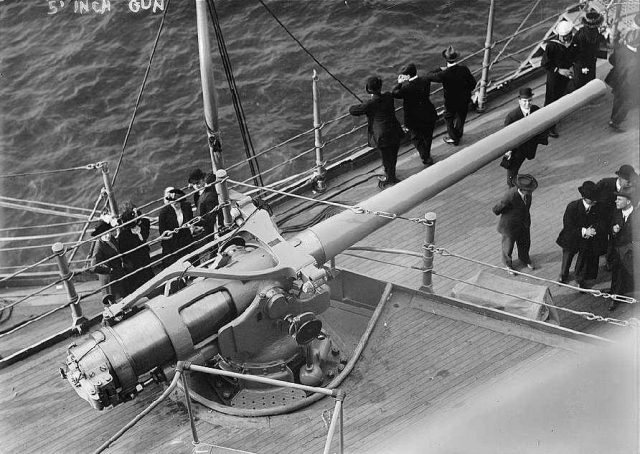
127-mm / 51 instrument
127-mm / 51 sample cannon 1910/11 g (Created by 1910 city, put into service in 1911 city) It was very powerful, it can be sent flying projectile weight 22,7 kg at an initial rate 960 m / sec. The firing range at the maximum angle of elevation, is 20 city., It was approximately 78 cable. In this case, the gun was not pereforsirovannym, resource of its trunk reaches a very respectable 900 shots.
Armor-piercing projectiles and high-explosive had the same weight, but the content of the explosive armor piercing was 0,77 kg, and high explosive - 1,66 kg, thus as explosives used all the same Explosive D.
However, it is somewhat surprising, that in almost all of the available sources the author, US battleships devoted exclusively describes armor-piercing shell. Strictly speaking, this, of course, It is no proof, that explosive shells in ammunition US battleships were absent, but ... and to indicate, that guns manned by such shells no. AND, as we know, the main gauge of its battleships Americans provided only armor-piercing projectiles up to the Second World War.
But even if we assume, that mine caliber "Pennsylvania" and "Arizona" was originally explosive shells, it should be noted a very low content of explosives in them. So, in Russian fleet used in 120-mm / 50 sample guns 1905 g. (Vikkers) at 20,48 kg explosive projectile arr. 1907 g. there 2,56 kg trinitrotoluola, and polubroneboynyh shells arr. 1911 g weight 28,97 kg BB content reached 3,73 kg, that is more than twice greater than those in the American explosive shells of 127 mm / 51 guns!
Yes, our lost American gun ballistics, having a significantly lower initial velocity - 823 m / s for easy 20,48 kg projectile, and 792,5 m / sec 28,97 kg, but the impact of Russian missiles on a target such as "destroyer" would not be an example of greater.
Following, and a very significant lack of American weapons - it kartuznoe loading. here, of course, can recall, and that the above-mentioned 120 mm / 50 instrument also been loading kartuznoe, but the question is, Russian ships that these guns were installed either in an armored casemate (Battleships type "Sevastopol", armored cruiser "Rurik"), or even in the towers (Monitors "Squall"), but on the American battleships, with their scheme of booking an "all or nothing" 127 mm / 51 gun battery mine had no body armor. And this created certain difficulties in the battle.
Upon reflection torpedo attack, battery mine should reach a maximum rate of fire (not at the expense of accuracy, of course), but it was necessary to have a certain reserve of projectiles and charges in 127-mm / 50 guns. These stocks were not covered by armor, and then the presence of liners could give them at least some protection, I hope, that if such stock and detonates on impact or debris fire, at least not completely.
Again - keep the calculations in the unprotected guns during the battle of linear forces did not make much sense, so that in the event of fires, they could not quickly intervene and correct the situation.
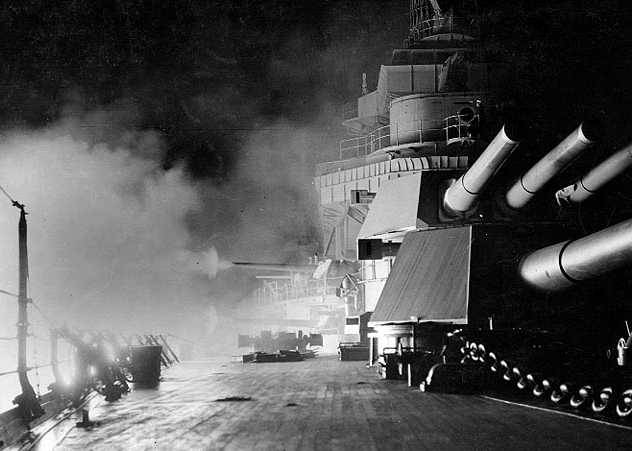
Fire is Mine caliber battleship «California»
In other words, It turns out that Americans had to lay out or left unattended and ammunition stockpiles before the fight, the risk of fires and explosions, but still be able to, if necessary, cause calculations to the guns, and immediately open fire. Or not to do so, but then put up with, that in case of a sudden attack of a threat of mines quickly open the fire will not work. The situation was aggravated by the fact, that the ammunition lifts at the time of the attack destroyers may be damaged (is the citadel), and then, the lack of "emergency reserve" at the guns would be quite wrong.
Generally, all of the above to a certain extent true for the casemate guns, but still do not have a recent example in better protection for the guns and their calculations, and are able to provide much better safety for ammunition from guns.
In addition to the above,, mine battery battleships such as "Pennsylvania", although it had a slightly better location relative to the previous type of ships, but remained very "wet", prone to flooding. However, this deficiency was very common in those days, so put it in rebuke to the creators of ships of this type, we will not.
Other business - fire control. In contrast to the main battery, to which to "Pennsylvania" and "Arizona" "annexed" quite modern system of centralized fire, somewhat different in design from the British and German counterparts, but generally quite effective, and, in some respects, perhaps even surpass the European MSA, centralized management of anti-mine caliber guns for a long time did not have centralized management in general, and were directed individually.
true, There were fire control group officers, whose battle stations were placed on the bridges of lattice masts, but they gave only general guidance. Centralized management of mine artillery fire appeared on the American battleship only 1918 g.
antiaircraft weapons
Upon entry into operation of battleships was presented 4 caliber guns 76mm / 50. These guns were quite equal a lot of other guns of the same purpose, appeared at the time on the battleships of the world. Antiaircraft "trehdyuymovki" fired a shell weighing 6,8 kg at an initial rate 823 m / sec., rate could reach 15-20 rds. / min.
When firing fixed ammunition used, wherein the maximum barrel lifting angle reached 85 city. Maximum range (at an angle 45 city) was 13 350 m or 72 cable's length, the maximum reach height - 9 266 m. Centralized management of these instruments, of course, did not have.
torpedoes
Need to say, that the torpedo is not particularly popular in the US Navy. Assuming conduct their battle for the oceans, US admiral did not consider it necessary to build large quantities of destroyers and destroyer, which we have seen, essentially, coastal vessels. This point of view has changed only during the First World War, When the United States embarked on a massive build ships of this class.
Such views could not but affect the quality of American torpedoes. Navy used 533-mm "torpedoes" production company "Bliss" (the so-called "Bliss-Levitt"), various modifications which have been taken into service in 1904,1905 and 1906 gg. However, they are inferior to their European TTX torpedoes, We had very weak charge, consisting, in addition, of gunpowder, not trinitrotoluola, and very low operational reliability. to exercise the share of unsuccessful launches of these torpedoes reached 25%. At the same time, American torpedoes had a very nasty habit astray, gradually turning on 180 city., while US battleships usually operated in the wake ranks: so there was a fair amount of danger of hitting their same battleships, following the fire a torpedo ship.
The situation had improved somewhat since the adoption of the service in 1915 g. torpedo "Bliss-Levitt" Mk9, which had the charge 95 kg TNT, although this has been very little. Range of stroke, according to one, was 6 400 m of 27 with., on the other - 8 230 m of 27 with. or 5 030 m of 34,5 with., length - 5, 004 m, weight - 914 or 934 kg. However, say exactly, what exactly torpedoes were equipped battleships such as "Pennsylvania" on the date of entry into operation the author of this article is not known.
"Pa" and "Arizona" is equipped with two torpedo tubes traverznymi, located in the building in front of the bow of the main fire towers. In general, such a minimalist would be welcome, if not ... the ammunition, numbering as many as 24 torpedo. In this case, the width of the ship did not have enough on the, to allow loading from the end of the torpedo tube, that is the classic way: so that the Americans had to come up with a very cunning (and extremely pereuslozhnennuyu of British opinion, had the opportunity to inspect the torpedo US phones) side loading design.
This concludes the description of weapons battleships such as "Pa" and proceed to "highlight" of the project - the reservation system.
To be continued…
/Andrew from Chelyabinsk, topwar.ru/







